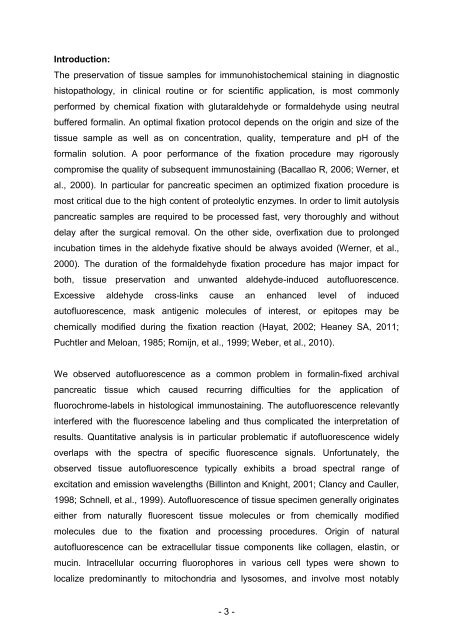Tierärztliche Hochschule Hannover - TiHo Bibliothek elib
Tierärztliche Hochschule Hannover - TiHo Bibliothek elib
Tierärztliche Hochschule Hannover - TiHo Bibliothek elib
Sie wollen auch ein ePaper? Erhöhen Sie die Reichweite Ihrer Titel.
YUMPU macht aus Druck-PDFs automatisch weboptimierte ePaper, die Google liebt.
Introduction:<br />
The preservation of tissue samples for immunohistochemical staining in diagnostic<br />
histopathology, in clinical routine or for scientific application, is most commonly<br />
performed by chemical fixation with glutaraldehyde or formaldehyde using neutral<br />
buffered formalin. An optimal fixation protocol depends on the origin and size of the<br />
tissue sample as well as on concentration, quality, temperature and pH of the<br />
formalin solution. A poor performance of the fixation procedure may rigorously<br />
compromise the quality of subsequent immunostaining (Bacallao R, 2006; Werner, et<br />
al., 2000). In particular for pancreatic specimen an optimized fixation procedure is<br />
most critical due to the high content of proteolytic enzymes. In order to limit autolysis<br />
pancreatic samples are required to be processed fast, very thoroughly and without<br />
delay after the surgical removal. On the other side, overfixation due to prolonged<br />
incubation times in the aldehyde fixative should be always avoided (Werner, et al.,<br />
2000). The duration of the formaldehyde fixation procedure has major impact for<br />
both, tissue preservation and unwanted aldehyde-induced autofluorescence.<br />
Excessive aldehyde cross-links cause an enhanced level of induced<br />
autofluorescence, mask antigenic molecules of interest, or epitopes may be<br />
chemically modified during the fixation reaction (Hayat, 2002; Heaney SA, 2011;<br />
Puchtler and Meloan, 1985; Romijn, et al., 1999; Weber, et al., 2010).<br />
We observed autofluorescence as a common problem in formalin-fixed archival<br />
pancreatic tissue which caused recurring difficulties for the application of<br />
fluorochrome-labels in histological immunostaining. The autofluorescence relevantly<br />
interfered with the fluorescence labeling and thus complicated the interpretation of<br />
results. Quantitative analysis is in particular problematic if autofluorescence widely<br />
overlaps with the spectra of specific fluorescence signals. Unfortunately, the<br />
observed tissue autofluorescence typically exhibits a broad spectral range of<br />
excitation and emission wavelengths (Billinton and Knight, 2001; Clancy and Cauller,<br />
1998; Schnell, et al., 1999). Autofluorescence of tissue specimen generally originates<br />
either from naturally fluorescent tissue molecules or from chemically modified<br />
molecules due to the fixation and processing procedures. Origin of natural<br />
autofluorescence can be extracellular tissue components like collagen, elastin, or<br />
mucin. Intracellular occurring fluorophores in various cell types were shown to<br />
localize predominantly to mitochondria and lysosomes, and involve most notably<br />
- 3 -









![Tmnsudation.] - TiHo Bibliothek elib](https://img.yumpu.com/23369022/1/174x260/tmnsudation-tiho-bibliothek-elib.jpg?quality=85)






